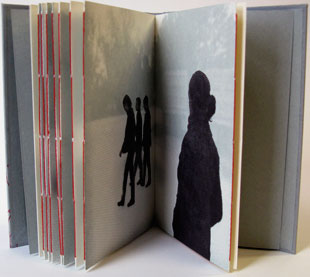5 x 7"; gatefold structure. Letterpress printed from polymer plates and Perpetua metal type on Arches Text and Wyndstone Vellum. [N.B. The colophon says the transparent material is Chartham Natural Clear, but this is wrong. Bryant's Creative Thesis cites many problems with Wyndstone Vellum: "I apparently hated this material to such a degree that I didn't even want it in my colophon, accidentally citing a paper I had used in some earlier mockups as the transparent material for the book."]. Endsheets: Fabriano Ingres. Casebound: German flatback case with 6mm joint. Cloth bound, blind stamped. Sarah Bryant: "An exploration of one moment and location, one position in space and time. This book was designed, printed and bound over the course of two years....If all goes according to plan, this book should satisfy my thesis requirements for the MFA in Book Arts from The University of Alabama." "Objectives: When I embarked on this project in the spring of 2007, I started with a series of simple guidelines. I wanted to incorporate the structural device of the dissection plate into a book that dealt with a person's relationship to their immediate, everyday environment. I wanted to create a book with a relatively simple binding in a significantly larger edition than my other books, printed in editions of 45. I wanted to work primarily with imagery, using text sparingly. "Design: ... I hit upon the gate fold as an ideal structure for the book. The gate fold allows for the simultaneous dissection of the recto and verso pages. It was the simplest structural solution to the problems inherent in creating a series of dissected spreads. As in my other books, the structure and content of this project are linked: one cannot be developed without the other.... [Questions as to how to use the structure led the artist to these conclusions] "Initially, I believed that these groups of people should be environmentless, simple halftone figures floating in a white space. ... [but I] realized that those that included an environment were much more interesting. The surroundings of these people were critical to the book, helping both to establish a position in time and space, and to reinforce that these spreads were connected in some way.... "... the back sides of the gate folds ... presented a challenge. Somehow, this space needed to introduce each spread and use a system which unified the book.... I decided to use a map, complete with dots to indicate locations of people. I used red to highlight the groupings which would immediately follow each map. The central point, which represents the observer whose perceptions the book explores, is gray throughout all of these maps, save the collection of dots on the title page, where it is red.... Determining the text: ... I decided on a combination of two text systems. First I inserted a small amount of text that indicated direct (printed in black) and overheard (printed in gray) dialogue. It is my hope that using dialogue places this book in a moment and an environment, and helps to set up the idea of being aware, sometimes inadvertently, of the immediate environment; of being an observer and eavesdropper. The second system, punctuation, gives an abstract indication of the relationships between the groups of people in the book. I used ampersands, ellipses, brackets and asterisks: punctuation whose basic function is to indicate that something is missing or anticipated. Brackets include and exclude. Asterisks highlight something unusual or important, and ask you to seek an explanation elsewhere. It is my hope that the punctuation sets up a system of classification that highlights themes of inclusion and isolation." |
